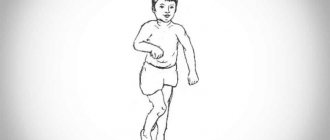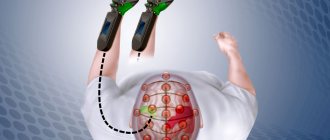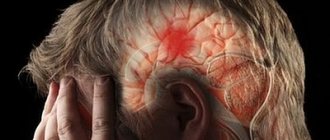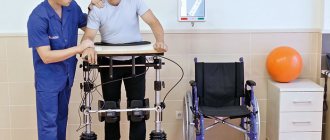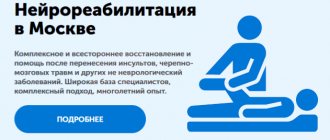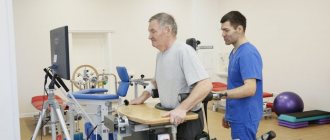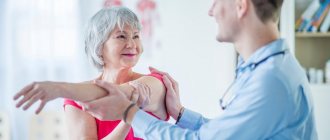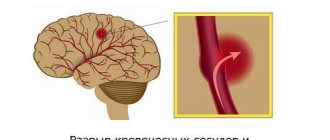Stroke is a cerebrovascular accident caused by rupture or blockage of blood vessels. Typically, the cause of this pathology is the long-term course of the following diseases: arterial hypertension, vasculitis, atrial fibrillation, atherosclerosis or venous insufficiency. If you detect the first signs of a stroke, you should immediately call an ambulance, since it is the timeliness of medical care that determines how severe the consequences will be and whether the patient will be able to return to their usual lifestyle.
If a patient has a stroke, a highly qualified and experienced doctor will be able to return him to a full life. Highly qualified doctors work at the Yusupov Hospital in the neurology and rehabilitation clinic. Acute disruption of cerebral blood supply is the second cause of mortality after heart disease. In more than half of cases, a stroke leads to disability. Doctors at the Yusupov Hospital have been treating patients who have suffered a stroke for a long time.
The hospital is equipped with modern equipment, all the specialists are of a high level, and good care for patients contributes to their rapid recovery. Although a long period of rehabilitation takes a lot of time, under the guidance of our specialists the quality of life of the patient and his family significantly improves. At the Yusupov Hospital you can undergo diagnosis, treatment and rehabilitation after a stroke.
Stroke: clinic and treatment
Treatment of acute stroke will be more successful if you consult a doctor in a timely manner. If you or a loved one:
- concerns about dizziness, nausea, weakness or numbness in the limbs;
- there were difficulties in swallowing, speech functions were impaired;
- drowsiness, inability to adequately respond to what is happening around;
- inability to maintain a stable position, impaired consciousness.
In this case, a hemorrhagic or ischemic stroke of the brain can be suspected in time, the treatment of which should be carried out only in a hospital setting.
What symptoms require hospitalization?
Signs of a stroke are the following:
- speech is impaired, the person has difficulty pronouncing simple phrases, confuses syllables;
- vision deteriorates sharply;
- an acute headache occurs for no particular reason, dizziness appears;
- on one side of the body there is weakness, numbness, even paralysis of the muscles of the face, arm or leg;
- Coordination and gait are impaired.
If at least one of these symptoms appears, emergency hospitalization and initiation of treatment are necessary.
Effective treatment of stroke: innovative technologies to protect your health
Therefore, the global medical community has developed not only a program whose goal is to prevent stroke, treating the consequences and restoring the body takes a large part in their research. Our specialists take an active part in scientific research and have created their own effective program that literally gets patients back on their feet. Modern treatment makes it possible to restore the functionality of the limbs, relieve dizziness and dysfunction of the speaking apparatus. Of course, once a stroke is diagnosed, hospital treatment becomes mandatory.
We are able to bring an atmosphere of home comfort into a hospital environment and provide psychological comfort to the patient. The stroke treatment center ensures that the patient will be provided with everything necessary, including equipment for rehabilitation and examination, the involvement of outside specialists and studies will not be needed anywhere else.
Stroke treatment is carried out in Moscow; convenient transportation simplifies contact between relatives and patients, and gives them the opportunity to visit the patient as much as possible and necessary.
First aid
If a stroke is suspected, the patient needs to wait for an ambulance, because it is the ambulance team that carries out the initial stabilizing measures.
At the Yusupov Hospital you can order an ambulance that will instantly take you to the hospital. When calling an ambulance, the patient's relatives and friends must explain to the dispatcher the symptoms that accompany a stroke. At the Yusupov Hospital, a qualified ambulance team, which specializes specifically in neurological diseases, responds to such calls. She drives a specially equipped vehicle in which emergency resuscitation measures and diagnostic tests can be carried out. Make an appointment
Stroke treatment: what do we offer?
In order to completely eliminate a cerebral stroke, treatment must be carried out under the supervision of highly professional doctors. Specialization of our doctors:
- Ischemic stroke of the brain, the treatment of which is quite successful even in very complex cases when one side of the body is paralyzed.
- Hemorrhagic stroke is a disease whose course is not accompanied by paralysis, but nevertheless requires an immediate response from doctors. The slightest delay or lack of professionalism can lead to disability, so do not experiment - call us immediately.
Upon entering our clinic, the patient immediately undergoes simple and perfusion computed tomography, as well as tomography of the neck vessels. The drug treatment for stroke depends on the results of the examination. Also, if necessary, invasive diagnostic angiography is performed, which will determine the location and size of the blood clot. Also, during the procedure, the blocked artery can be cleared mechanically.
In each specific case, depending on what kind of stroke is diagnosed, the cost of treatment may vary. The recovery plan is developed individually.
If a cerebral stroke is diagnosed, treatment may include:
- Drug therapy that will expand the lumen in the vessel and allow blood to flow freely.
- Surgery, including anatomical bypass, arotid endarterectomy of cerebral vessels, or installation of stent grafts in the carotid artery.
- Physiotherapy and rehabilitation treatment after a stroke will allow you to gain the opportunity to lead a full life. Exercise therapy specialists work with each patient according to an individually developed program for getting rid of the consequences of a stroke, which makes treatment even faster and more effective.
We cannot always predict the development of the situation, but we can say one thing for sure - stroke treatment in the hospital is carried out by doctors who make every effort to achieve a high result. We work to ensure that you live a full life.
Causes of stroke
Strokes occur both due to lack of nutrition in a part of the brain and due to hemorrhage. When the lumen of a vessel is blocked by an atherosclerotic plaque, thrombus, or embolus, an ischemic stroke develops, but if the stroke was a consequence of damage to the vessel and hemorrhage occurs, it is called hemorrhagic. The time of diagnosis and which doctors provided assistance are also important - the earlier and more correct the assistance is provided, the more positive the outcome. To diagnose cerebral blood supply disorders, it is necessary to use stroke recognition techniques:
- When trying to smile, you need to pay attention to the corners of the mouth - in case of a stroke, it can be directed downwards, the smile looks crooked and asymmetrical;
- When trying to speak, it may be difficult to pronounce even the simplest words and sentences;
- When trying to raise both arms, asymmetry is observed;
- The protruding tongue falls to the side.
If at least one of the symptoms is positive, you must immediately call an ambulance.
Under no circumstances should you give him water, feed him, lift him, or take him by handy transport to the nearest hospital, as this can cause harm. In severe cases, there is a need for cardiopulmonary resuscitation on site or in an ambulance. Hospitalization in the event of a stroke is mandatory. As a rule, the patient remains in the intensive care unit until his condition is completely stabilized, with further transfer to the neurological department.
Treatment of stroke consists of a set of emergency actions and a recovery period, which takes quite a long time and is carried out in several stages. Treatment includes medications, physiotherapeutic procedures, and following the recommendations of related specialists. The characteristics of patient care are also important.
Minimally invasive surgery: gentle treatment after ischemic stroke
One of the most common ways to neutralize the consequences of a stroke is treatment using a technology such as thrombolysis. During an angiogram, a drug is injected directly into the area where the blood clot has formed. The blockage disappears and blood circulation is restored.
Additionally, drugs are introduced that improve metabolic processes in the brain, so that after a stroke, treatment is faster and more effective. Delay is unacceptable; a diagnosis such as stroke can be treated in a hospital well with a timely response from doctors, when the brain has not yet received irreversible damage.
Symptoms
You are at risk if you agree with one or more of the following:
- one of the blood relatives has already suffered a stroke;
- a tendency to microthrombosis was diagnosed;
- was diagnosed with diabetes mellitus;
- you are a heavy smoker or drink alcohol in large quantities;
- weight significantly exceeds normal;
- Serious circulatory disorders in the brain have already been recorded;
- you suffer from one of the following diseases: angina pectoris, encephalopathy or arterial hypertension.
Physiotherapy: stroke treatment, inpatient rehabilitation
How else can modern medicine help? Stroke treatment and rehabilitation must be comprehensive, including physical therapy. Stimulation of the nervous system will help restore brain cells and restore lost functions to a person.
Once a left-sided stroke is diagnosed, treatment may include:
- massage;
- classes with a neuropsychologist and psychotherapist;
- physical exercise.
Not everything, of course, depends on the doctors - recovery will be faster if the patient himself makes every effort and does not give up. For our part, we will make every effort to create a favorable atmosphere.
The page is for informational purposes only. Find out the exact list of services provided and the specifics of the procedures by calling.
Help in the acute period
Which doctors are needed in the treatment of stroke depends on the period of the disease, but in any case, they must be experienced, highly qualified specialists who know how to properly provide assistance in this situation.
When diagnosing an ischemic stroke in a patient, the doctor’s goal is to restore blood supply with subsequent rehabilitation. This may require blood thinning medications or mechanical removal of the clot using a catheter. To remove atherosclerotic plaques, endarterectomy is performed, and to increase the diameter of blood vessels, plastic surgery with stenting is performed.
In the case of a hemorrhagic stroke, it is necessary to stop the bleeding, reduce intracranial pressure, and in the case of compression of the brain, it must be removed surgically.
Care for severe illness after a stroke
The question of how to care for a patient after a stroke becomes especially acute if the stroke provoked serious brain damage, causing complete paralysis, loss of speech, memory and other disorders. Caring for an elderly relative in this case requires:
- constant monitoring of physical indicators and medication support;
- regular courses of physiotherapy and massage;
- working with specialists in the restoration of speech and motor skills;
- providing psychological support.
Caring for a severe stroke patient at home can be challenging. It requires strength, patience, endurance. Complicating the situation is the fact that the reversibility of changes caused by the disease is called into question. However, with due persistence and effort, in most cases it is possible to improve the patient’s physical condition and regain lost abilities (partially restore body functions).
Caring for paralyzed patients after a stroke at home
One of the most severe consequences of a stroke is paralysis and loss of motor activity. After standard treatment, the patient with these disorders is discharged from the hospital and sent to rehabilitation. Relatives can organize care for a paralyzed patient after a stroke at home, providing the patient with:
Adapted conditions of stay
Care after a stroke at home requires comfort for the patient and his environment. It is best to allocate a separate room for the old man, providing:
- peace and quiet, since loud conversations, screams, noise can irritate and disturb the patient;
- access to fresh air and the possibility of ventilation;
- a comfortable level of illumination that does not cause irritation or disturbance (it is better to cover the windows with curtains or blinds).
The room should be cleaned regularly and kept in order. To optimize care after a stroke, it is better to take care of purchasing a special bed and an orthopedic mattress. With their help, it will be easier to move a person and perform care procedures. In addition, you need to take care of purchasing:
- quality bed linen;
- diapers (if necessary);
- dishes;
- hygiene products.
If an older person is still able to move, they should be supported. Buying crutches or a walker solves problems to a certain extent.
Access to rehabilitation therapy
The consequences of a stroke manifest themselves in various dysfunctions of the body. Often, patients after a stroke need support and restoration of their physical condition. Physiotherapy and exercise therapy have a significant effect on the body and increase the effectiveness of rehabilitation measures. Thanks to regular exercise therapy and massage, you can:
- stimulate blood circulation;
- improve muscle tone;
- increase receptor sensitivity;
- relieve congestion.
Speech restoration
It is not uncommon for stroke care to require work aimed at restoring speech function. Home activities in this case may include:
- classes with a professional defectologist/speech therapist;
- regularly performing simple exercises (rhymes, counting rhymes, tongue twisters);
- everyday communication and involving a person in conversation.
Restoring speech has a positive psychological effect on a person, instills confidence in the success of treatment, and prevents the formation of depressive moods and despondency.
Monitoring for bedsores
In bedridden patients after a stroke, bedsores may appear, the presence of which serves not only as a source of extremely painful sensations, but also as a gateway to infection. The task of relatives is to dynamically monitor the patient’s skin, maintain hygiene, and take preventive measures in a timely manner.
Sanitary care
Caring for patients after a stroke at home requires competent sanitary care for the patient. Relatives need to learn a number of important skills that will help them effectively maintain cleanliness and hygiene:
- changing bed linen: the procedure requires accuracy and speed of manipulation, while clean linen guarantees the convenience, comfort and safety of the patient;
- morning toilet: oral hygiene, washing – basic procedures are important to perform regularly and in full; they should be carried out on the bed if the person is lying down, or in the bathroom, but accompanied;
- bathing: it is allowed to transport the person to the bathroom or wet wipe directly on the bed;
- changing clothes: it is important to regularly change underwear, using clothes made from natural fabrics that do not cause irritation and discomfort;
- toilet: it is important to control the frequency and volume of bowel movements, since this process says a lot about the functioning of the body, constipation must be avoided. If the patient is bedridden, then the use of diapers simplifies care, but requires additional attention to the cleanliness and care of the skin under the diaper.
- control of functional indicators: it is necessary to regularly measure temperature, pressure, monitor the rigidity of breathing, the cleanliness and condition of the skin and mucous membranes.
The task of relatives is to organize the stay of an elderly relative in comfort and coziness, as well as to provide him with comprehensive support and assistance.
Stages of medical care for patients with acute cerebrovascular accident
Pre-hospital stage
Ambulance and emergency medical aid station team:
- Detects a stroke and determines the period from the onset of the disease, makes an informative call to the hospitalization department;
- Delivers patients with acute stroke in the shortest possible time;
- Provides observation of patients and treatment at the prehospital stage in accordance with the standards of medical care for patients at the prehospital stage, with blood pressure monitoring at the values recommended for maintaining perfusion levels;
- It is possible to use neuroprotectors: glycine 1.0 sublingually, magnesium sulfate 25% 10 ml IV, ethylmethylhydroxypyridine succinate (Mexidol) 200 mg IV, citicoline (Ceraxon) 1000 mg IV;
- It is necessary to avoid the use of aspirin (ASA, CardiASA, thromboASS, aspirinCardio), glucose as a solvent (possible TLT);
- Vasoactive substances and nootropics are not recommended;
- Transport the patient in a horizontal position without lifting the head end to maintain perfusion, but with control of possible aspiration of vomit;
- At the prehospital stage, there are no unconditionally proven effective treatment methods and diagnostic signs that make it possible to absolutely accurately determine the nature of the stroke and carry out early pathogenetic therapy;
- The concept of “time is brain” and the concept of “therapeutic window” mean that stroke care should be urgent while minimizing transport delays.
Hospital stage
A multidisciplinary approach begins already at the diagnostic stage (stroke unit team).
Held:
- Blood pressure measurement;
- ECG (possibly during hospitalization);
- Glucosemetry (if not performed at the emergency stage);
- Installation of a cubital catheter (possible at the prehospital stage);
- Blood collection for laboratory analysis;
- General analysis (platelets!);
- Coagulogram – INR (international normalized ratio), APTT (active partial thromboplastin time);
- Biochemical analysis (urea and creatinine, liver tests) (possible at the prehospital stage).
Organization of the maximum possible implementation of diagnostic procedures at the prehospital level significantly reduces the time “from door to needle,” which determines the greater effectiveness of thrombolytic therapy.
- Analysis of CT, MRI data;
- Ultrasound examination of blood vessels within 3 hours after admission, heart (for cardioembolic stroke) - as indicated.
The neurologist on duty conducts:
- Taking anamnesis;
- Neurological examination (NIHSS);
- Identification of contraindications to thrombolytic therapy (TLT), choice of management tactics.
Consultation with a neurosurgeon is mandatory for hemorrhagic stroke or extensive cerebellar infarction within 60 minutes.
Consultation with a cardiologist is necessary for all patients diagnosed with stroke or suspected TIA.
Preventing bedsores
Competent care for paralyzed patients after a stroke at home requires attention to the problem of bedsores that arise as a result of prolonged lying. Their presence causes additional suffering in the patient, which aggravates the course of the disease and can cause death.
Damage to the skin (bedsores) begins to form in bedridden patients in places of maximum body pressure on the surface of the bed. Most often, ulcerations occur on the skin of the back, tailbone, and elbows. In these areas, metabolic processes are disrupted, leading to gradual death and necrosis. The cause of the problem lies in the lack of movement. A paralyzed person cannot roll over on his own, so relatives who take care of the patient after a stroke should carefully monitor the implementation of hygiene measures and regularly engage in the prevention of skin defects.
A set of measures to prevent the occurrence of bedsores includes:
- correct and safe preparation of the sleeping area: without folds, foreign objects, seams;
- regular change of body position of an immobilized patient;
- daily examination of the skin and careful examination of areas exposed to increased pressure;
- acquisition and use of special equipment: a mattress with an anti-decubitus effect, pillows and rings that reduce the area of contact with the bed;
- regular massage;
- compliance with hygiene measures: washing the body with soap and treating with antiseptic agents.
It is important to ensure that a bedridden patient after a stroke is clean and well-groomed. Mandatory hygiene procedures, changes in body position, and massage help prevent the risk of skin defects. Under such conditions, the chances of restoring motor functions are significantly increased. Quality care can be considered one of the key factors for successful rehabilitation.
Logistics of acute stroke
The logistics of acute stroke implies mandatory hospitalization during the “therapeutic window”, rapid transportation of the patient (“time is the brain!”), making a telephone call by the ambulance team to the hospitalization center, preparing the stroke team to admit the patient to a specialized department, round-the-clock operation of MRI ), ultrasound diagnostics of the great vessels of the head and heart, laboratories. “Time from door to CT, MRI” should not exceed 15 minutes, “time from door to needle” should generally not exceed 40 minutes.
Features of feeding patients after a stroke
Eating is necessarily included in caring for a patient after a stroke and requires certain skills in organizing the process. It is important to properly develop a diet, select a menu, and also organize feeding a person. Restoring and supporting digestive function creates the basis for the patient’s recovery.
A stroke can negatively affect the functioning of the digestive system. That is why it is important to increase the fiber content in the patient’s diet, which stimulates the gastrointestinal tract. It is important to take care of the nutritional value of food, as well as the form in which the dishes are served. The patient's diet should be as varied as possible. For better absorption, preference should be given to liquid foods or pureed foods.
Before feeding, it is necessary to calm the person down and create comfortable conditions for him. A bedridden patient must be seated. If motor functions are limited, then the old man must be fed from a spoon or using a special sippy cup. It is necessary to monitor the swallowing function so that the person does not choke.
3.Preventing recurrent stroke
Once emergency care has been provided and the patient's condition has stabilized, further stroke treatment is aimed at preventing another stroke. For this
goals, it is important to control risk factors for stroke, such as high blood pressure, atrial fibrillation, high cholesterol and diabetes. Your doctor will likely recommend certain medications to help you feel well.
Lifestyle changes are also important to prevent stroke. It would seem that the measures are very simple and known to everyone, but they really help. Quitting smoking, limiting alcohol consumption, exercising, and eating a balanced diet low in cholesterol, fat, and layers are all recommended not only for the treatment of stroke after primary care and for the prevention of stroke, but also for the prevention of other serious diseases.
In some cases, doctors recommend carotid artery stenting
. It will help unblock the artery and restore normal blood flow through it.
About our clinic Chistye Prudy metro station Medintercom page!
Factors influencing stroke outcome during TLT
- 1. Time to start therapy: the sooner the better!
- 2. Clinical signs that worsen the outcome of TLT: age over 85 years
- severe stroke (more than 25 points on the NIHSS scale)
- Blood pressure above 180/110 mmHg
- hypodensity of more than 1/3 of the MCA basin
Thus, the question of whether IV TLT is the best treatment method for patients with ischemic stroke remains relevant. After years of continued improvement in endovascular techniques and devices, endovascular neurosurgeons have now achieved unprecedented rates of revascularization for MCA occlusion, with decreased procedure times, very low rates of intracerebral hemorrhage, and favorable outcomes. After more than a decade of attempts at IA TLT using all available drugs, doses, and combination techniques with only modest results, we are entering the era of mechanical thrombectomy. Without a doubt, modern endovascular revascularization techniques have changed the course of the disease in MCA occlusion much more than IV TLT. This is convincing evidence that the endovascular treatment method, if in capable, experienced hands, should be considered the treatment of choice for MCA occlusion!
How to care for patients after a stroke?
The rules for caring for stroke patients, the scope of rehabilitation measures, and the nuances of providing assistance are determined in accordance with the severity of symptoms, the extent of brain damage, concomitant health conditions, and the patient’s age. As part of your care arrangements, you can:
- rely on the strength and skills of relatives;
- invite a caregiver/nurse to your home;
- place a relative in a boarding house for the elderly.
The decision to organize care for an elderly person after a stroke is important to make based on living conditions, financial capabilities, physical and moral readiness to help and support the old person.
In addition, the earlier a person’s signs of the disease are identified and medical care is provided, the more effective and quicker his rehabilitation is. Of course, with older patients the task is complicated by the presence of concomitant pathologies, but care and hard work for results help improve physical condition and improve the quality of life.

